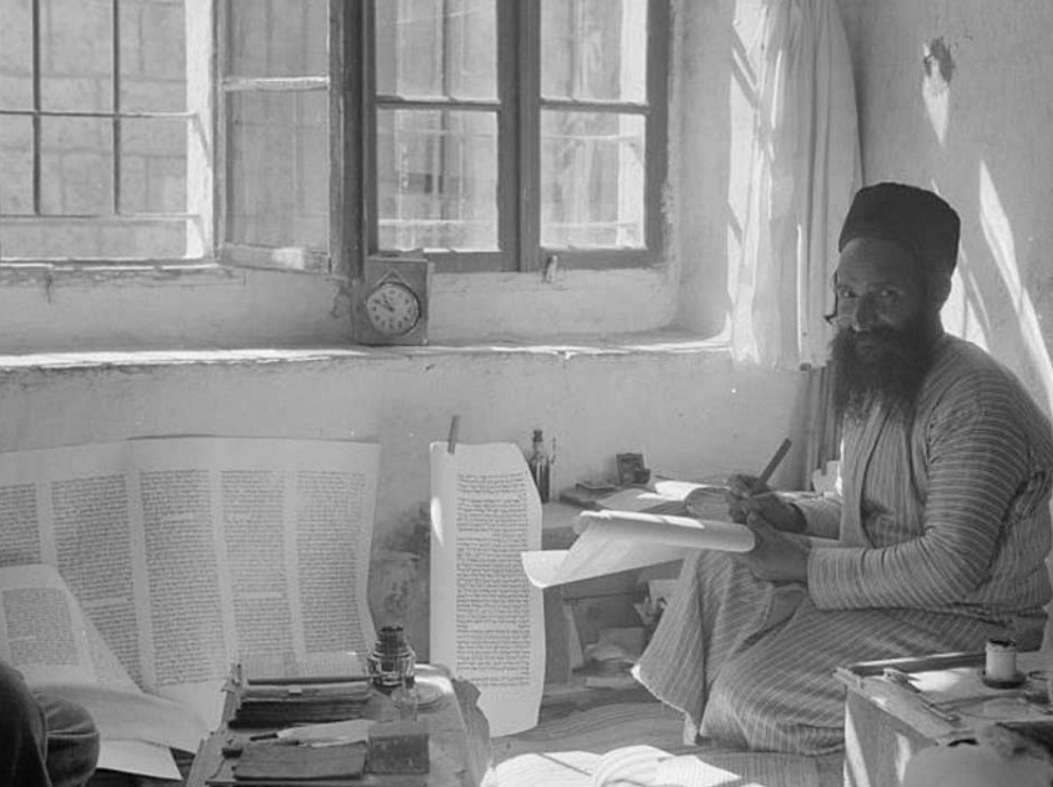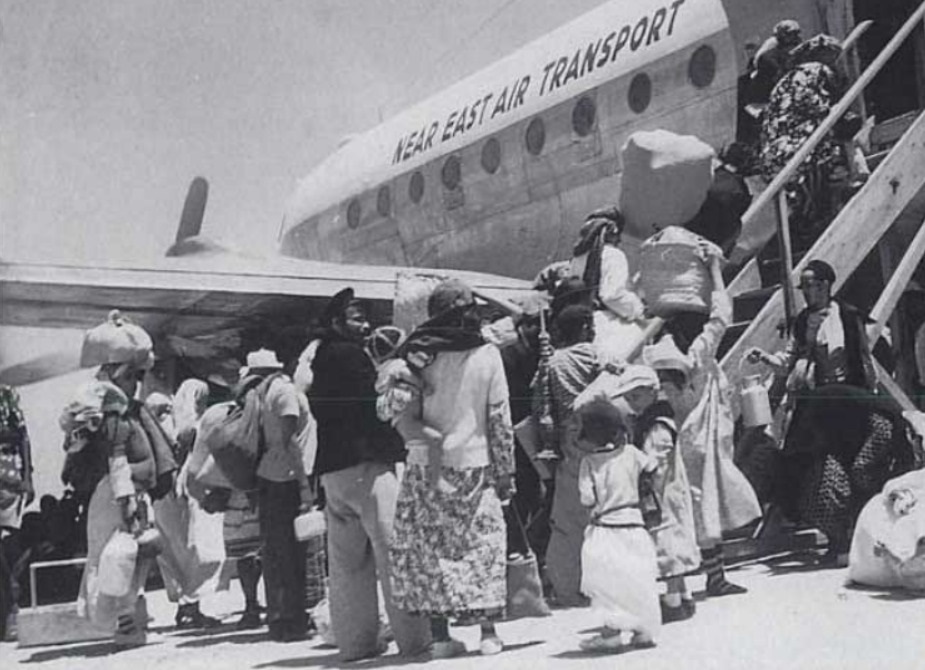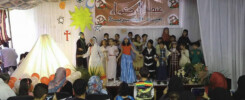Who are the Jews of Yemen?
There are no historical documents that irrefutably define the nature of the presence of Jews in Yemen. However, Yemeni Jews (known also as Yemenites) have been an integral part of society, and are considered to be indigenous Yemenis. Judaism was a religion with a large following in ancient Yemen, which a society that believed in different local religions, as was the case during the reign of the Kingdom of Sheba, Himyar, Qataban and other ancient kingdoms of Yemen. Judaism was widely spread among a wide segment of the people over several centuries, alongside the Muslims who made up the vast majority of Yemenis.

Historical Background:
The earliest historical inscription bearing the characteristics of Judaism is the Grinian inscription of Beit Al-Ashwal (1), which dates back to the late 4th century and early 5th century, during the reign of the Himyarite king (Dara’a Amr Ayman), the brother of the famous Himyarite King Abkrab Asa’ad Al-Kamel. This indicates that Judaism was widespread to a certain degree at the time. These inscriptions indicate the existence of Jewish communities with a prestigious social and economic status, but there are no indications that the kings of the fourth and fifth centuries embraced Judaism. However, this changed during the sixth century, with King Yusuf Asar Du Nuwas. It is also worth noting that these Jewish communities were comprised of indigenous people who converted to Judaism and were not Jewish people that came from another country. This means that Judaism was presented as an idea but its adherents were indigenous.
In his biography of the Prophet “al-Seerah al-Nabawiah”, Ibn Hisham wrote about the origin of Judaism in Yemen. He stated that Judaism in Yemen came through the Himyarite King As’ad Al-Kamil, who visited Mecca and Yathrib, and returned to his people with two Jewish rabbis. His people, however, did not approve of this and resorted to judgement through fire (an ancient pagan custom in Yemen), which resulted in a decision in favor of the rabbis. After this, Judaism spread in the Himyarite Kingdom. However, this account lacks any supporting historical documents or inscriptions.
According to the inscriptions found, Judaism continued to be the predominant religion in Yemen for over 150 years, after which a bitter conflict between Judaism and Christianity emerged in the country. This conflict reached its peak during the reign of King Yusuf Du Nawas (522–530), with the invasion of the foreign Axum army, the dominant Christian force in Ethiopia at the time, in response to Nawas’s punitive campaign against rebel Christians in Najran. This brought an end to the strong Jewish authority in Yemen, and Jews lost their strong foothold in southern Arabia. However, Judaism remained widespread among many Yemeni tribes. The spread of the religion was also slowed down, especially after the introduction of Islam to Yemen, after which many Jews began to convert to the new religion. The remaining Jews after that came under the Dhimmah system, which entitled Jews and Christians to live within the Islamic realm after paying the jizya tax.
We know almost nothing about the Jews in Yemen during the first Umayyad and Abbasid eras, up until the end of the ninth century, when the Zaydi Imamate was established in northern Yemen in 897 by Imam Yahya Al-Hadi. That is when a series of organized and unregulated abuses against Jews began, which have continued over the past 1,000 years. This transformed the Jewish population from being a large part of society to a smaller number of people deprived of the most basic elements of citizenship.
Areas of Jewish Presence in Yemen:
Jews have existed in different parts of Yemen and were concentrated previously in major cities because of their professions as craftsmen and traders. Nowadays, they are found in specific mountainous areas in Rida and Naat in Arhab. A number of them also moved into the “Tourist City” in the capital Sana’a, after they were attacked in their homes located in other remote areas of the country. According to an interview with the current head of the Jewish community in Yemen, the number of Jews in the country now does not exceed 43 individuals. They are distributed as follow: nine in Raida, two in Arhab, and 32 in Sana’a.
Religious Rites & Education:
Yemeni Jews used to practice their religious rituals in temples, but nowadays they practice them in their homes, after the destruction of their synagogues and the harassment and abuse by extremist groups (such as al-Qaeda and the Houthis). Dogmatically, Yemeni Jews are the closest to the Ashkenazi Jews, based in the state of New York, USA.
Among the religious rites practiced by Jews in Yemen are:
1- The Holy Saturday of every week.
2- Passover.
3- Yom Kippur.
4- New Year.
5- The Feast of Lights.
Jews in Yemen teach their children the Hebrew language and the Torah from the age of three under the supervision of a rabbi (a senior figure in the Jewish community chosen for his knowledge not age). At the age of six, they are sent to the United States or Israel to continue their religious studies, and usually return to Yemen after that. The rate of education for males is very low and is virtually null with females. Despite many offerings and temptations offered by the Jewish community in the United States to the Jewish community living in Yemen, some Yemeni Jews refuse to leave their country and prefer to return to live in their native homeland.

Their Relationship with the Authorities and Society:
Across almost a thousand years, Imams in the north of Yemen considered the Jews to be among Ahl Al-Dima’a, who had to pay a tribute jizya to the Imam. The jizya was a sum of money paid for each individual. Yet they were treated differently and in an inferior way to the rest of society. In the Yemeni Jewish tradition, a Jewish person would distinguish himself with a Payot, a lengthened part of the head hair at the ears to distinguish themselves from Muslims, and as a religious manifestation that distinguishes Jewish males.
During the British occupation in the south of Yemen, the Jews had a good relationship with the British authorities. They lived and learned with Muslims and other religious and ethnic communities, especially in the protectorate of Aden, and had classes that taught Hebrew. These communities had many similar traditions, and differed only by religion. The Jews in the south of Yemen had their own temples where they practiced their rituals freely. This however, changed after 1947, with the birth of the State of Israel and the intensification of the conflict in the Arab region with Israel. By 1967, the south had virtually no Jewish presence.

The Jews of Yemen Between the Present and the Future:
During successive regimes in Yemen, the Jews have suffered from marginalization, exclusion and discrimination, and they had no political representation. Their role remained confined to the artisanal and trade fields, and they were not allowed to play any political or administrative role. Even in modern Yemen, in which the constitution states that it is a pluralistic state, no Jewish citizen was ever allowed to be a member of parliament. Even though they presented a candidate during the last parliamentary elections in 2003, he was rejected because the Yemeni constitution requires any member of parliament to be committed to his religious obligations. This was interpreted to mean that non-Muslims are not eligible to run in a country whose constitution states that Islam is the official religion of the state.
Jewish Culture and Literature in Yemen:
Many Jewish manuscripts have been looted and smuggled, the last of which took place in 2017, when a historical manuscript of the Torah was taken to Israel. Yemeni Jews have developed rich traditions in all aspects of culture, such as in music, dance, architecture, clothing, embroidery, and gold and silver crafts. Many of Yemen’s Jews around the world continue to carry their own Yemeni customs and traditions that they are trying to preserve and protect from extinction, despite their presence in other societies which are quite different from the culture they grew up in. Many of these Jews around the world continue to be proud of their culture and their affiliation to Yemen, despite their displacement and exclusion over the past decades, especially during the last century.
Jews have contributed greatly to enriching Yemeni society culturally and artistically, and their artistic touches and style are still influential in the field of architecture, as can be seen in Sana’a and in other governorates around the country. People have been influenced by their lyrical art which is now part of the Yemeni heritage, and many Jews still retain it even in their distant exiles in different countries around the world, including in Israel.
Jews were also renowned for their excellent handicraft skills in fields such as silver crafting, janabi (daggers), embroidery, sewing, carpentry and blacksmithing, along with trade. They were also known for their punctuality, professionalism in their work, and for having good relationships with the rest of the community.

The remaining Jews in Yemen are unable to practice the trades which they inherited from their ancestors, due to the lack of resources and concern for their safety. Under the late President Ali Abdullah Saleh, the government approved $23 a month for each Jewish individual, along with other food aid.
Violations:
We will divide the violations against this sect into three stages:
The first occurred during the seventeenth century CE, specifically during the reign of Imam Al-Mahdi Ahmad Ibn Al-Hasan Ibn Al-Qasim (Imam of Yemen from 1676 to 1681), issued a decree banning all Jews from living in most cities and towns of the country, sending them to this dry and barren area. Only a few Jewish communities survived this fate, who lived in the eastern regions of the country (such as Niham, al-Jawf and Khulan), where the tribes refused to obey the Imam’s orders. Many Yemeni Jews died along the hard road to their exile in Moza’a. However, after about one year in exile, the Jews were summoned back from their exile to perform their usual duties, after Muslims complained to the Imam about the lack of goods and services that were well provided and performed by Jews.
At the start of the 19th century, the situation of the Jews of Yemen was very miserable. Subjected to the authority of the local Imam at the time, they were prevented from wearing new or good clothes, prevented from riding donkeys and mules, forced to walk to the left of the road and to not build houses more than one story high, as well as prohibited from wearing weapons or janabi (daggers). They were also prohibited from working in the field of financial transactions, and were all artisans who were mainly employed in carpentry, construction and blacksmithing. Yemen’s Jews had experience in a wide range of professions that tribesmen avoided in different regions (especially Zaidi regions). Occupations exclusively practiced by Jews included; silver crafts, blacksmithing, repairing weapons and tools, weaving, pottery, construction, carpentry, shoe making and sewing. In return, the Muslims oversaw the production and supply of food, while Jews provided them with all the manufactured tools needed by the Muslim farmers.
Other reports point to the systematic abuses carried out by some regimes in northern Yemen, including the so-called orphan law, which was imposed during the reign of Imam Yahya Hamid Al-Din in early 1920. This law stated that Jewish orphans would be adopted and raised to become Muslims. This idea arose earlier in time but became applicable in the early 20th century. Another notorious law enacted by Imam Yahya required Jews to clean streets and remains.
Secondly: In 1947, following the vote to divide the British Mandate for Palestine, bloody riots took place in Aden, killing 82 Jews and destroying many Jewish homes. The Jewish community in Aden was paralyzed by what happened, as most of their shops and businesses were destroyed. This situation led to the emigration of most of the Yemeni Jewish community between June 1949 and September 1950, during which time over 50,000 Jews emigrated to Israel.
Thirdly: Began with the wars of the Yemeni government with the Houthi movement in mid-2004 until the present day. The Houthi movement have always been hostile to the Jews. This is reflected in their well-known slogan “Death to Israel, Curse the Jews”, which they chant in all their activities and events. At the beginning of the Houthis’ displacement of the Jewish community, 70 members of the Al-Salem tribes in Sa’ada—the last remaining members of the Jewish faith in the area—were expelled to Sana’a. The Houthis have practiced in intimidation and threats against members of this community, and there are allegations that some members of the Houthi group abducted women from their husbands and married them to some of their followers, an act which violates all customs and laws.
With the expansion of the Houthis in 2011 to Amran and the killing of the preacher (Masha Yaish Nahari), the Jews of Amran fled the region with only four families remaining, including three families in Kharf (governorate of Amran), and one family in Arhab, numbering only 11 individuals.
In 2013, a Jew in Sana’a by the name of Harun Yusuf al-Zindani was murdered. And with the Houthis taking control of Sana’a, the Jews feared for their lives, forcing 30 individuals to escape and travel to Israel. A member of the Jewish community was also arrested on charges of smuggling an archaeological manuscript. This accusation came about through false allegations that had no basis in truth. According to INSAF’s findings from reliable sources, the rest of the defendants in this same case were released, but the Jewish individual remains to this day in custody due to his religious affiliation.
Yemeni Jewish Migrations to Israel Since 1881–2016
Despite all that has been said regarding the strong connection that the Jews of Yemen have to their country, historical facts prove that there have been serious violations against them. In addition to the difficult economic and political conditions that helped encourage them to emigrate to Israel, there are also fundamental religious reasons. According to their beliefs, they were promised to return to the promised land on “Winged Eagles”. The “Magic Carpet” operation, was one of the most important stages in which Jews emigrated from Yemen. For this, the Jews of Yemen flocked from different parts of the country to Aden, despite the harsh conditions at the time, with some of them arriving to Aden on foot. Operation “Magic Carpet” came to an end on the 24th of September 1950, which involved 450 flights carrying around 50,000 Yemeni Jews to Israel between 1949 and 1950.

Despite all the temptations offered to the Jews of Yemen, only 400 people emigrated between the period since the “Magic Carpet” operation and the 1962 revolution in northern Yemen. After these immigration journeys, there was not much left of the Jewish community in Yemen. While some 2,000 Jews were distributed in different areas among the Muslim community, some families dispersed, while some preferred to convert to Islam in order to cope with the new reality. Others left to join their families in Israel, which caused a drift between some members of the community.
Forty-three members of this religious group remain now in Yemen clinging to their homeland, while all the conditions around them and invite them to emigrate. This requires the community to protect this small minority, which is an important part of the of Yemeni society, culturally and intellectually.



